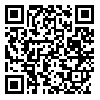BibTeX | RIS | EndNote | Medlars | ProCite | Reference Manager | RefWorks
Send citation to:
URL: http://jrsm.khu.ac.ir/article-1-2420-fa.html

 ، اکبر بهلول2
، اکبر بهلول2 
 ، شقایق مدبری1
، شقایق مدبری1 

2- دانشگاه تهران ،
دستگاه اندازه گیری هماهنگی حرکتی بین فردی و درون فردی برای قرار دادن اطلاعات مربوط به هماهنگی حرکات انسان در دسترس محققان، مربیان و درمان گران، طراحی و ساخته شده است. برای بررسی اعتبارسنجی این ابزار از 28 شرکت کننده با بهره گیری از آزمون هماهنگی دودستی دستگاه وینا و ابزار پژوهش حاضر خواسته شد تا تکلیف هماهنگی حرکتی دودستی، دوپایی و بین فردی را انجام دهند. نتایج آزمون همبستگی پیرسون نشان داد ابزار پژوهش حاضر در هماهنگی حرکتی دودستی در فاکتور میانگین کل زمان دسته (88/0r=) و صفحه گردان (96/0r=) و در فاکتور میانگین درصد زمان خطای دسته (89/0r=) و صفحه گردان (87/0r=) از روایی بالایی برخوردار است. همچنین نتایج آلفای کرونباخ نیز نشان داد ابزار پژوهش حاضر در هماهنگی حرکتی دودستی در فاکتور میانگین کل زمان دسته (89/0r=) و صفحه گردان (97/0r=) و در فاکتور میانگین درصد زمان خطای دسته (81/0r=) و صفحه گردان (85/0r=) از پایایی مناسبی برخوردار است. همچنین، در هماهنگی حرکتی دوپایی در فاکتور میانگین کل زمان پدال ها (90/0r=) و در فاکتور میانگین درصد زمان خطای پدال ها (83/0r=) و در هماهنگی حرکتی بین فردی در فاکتور میانگین کل زمان (91/0r=) و در فاکتور میانگین درصد زمان خطا (80/0r=) نیز نتایج، بیانگر پایایی قابل قبول بود. لذا استفاده از ابزار پژوهش حاضر را می توان به آزمایشگاه های علوم ورزشی در کلیه موسسات آموزش عالی، فدراسیون ها و مربیان ورزشی، بیماران و مراکز توانبخشی ها، کلینیک های درمانی و فیزیوتراپی پیشنهاد کرد.
دریافت: 1395/10/5 | پذیرش: 1396/5/10 | انتشار: 1399/6/10
| بازنشر اطلاعات | |
 | این مقاله تحت شرایط Creative Commons Attribution-NonCommercial 4.0 International License قابل بازنشر است. |






